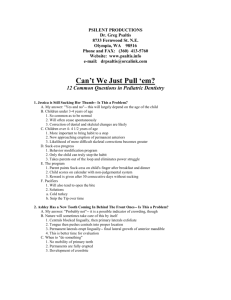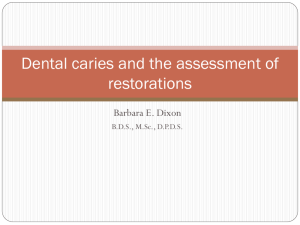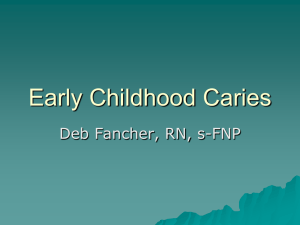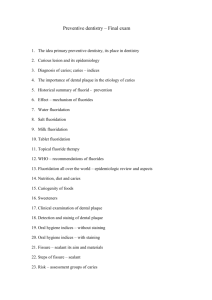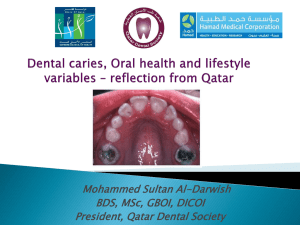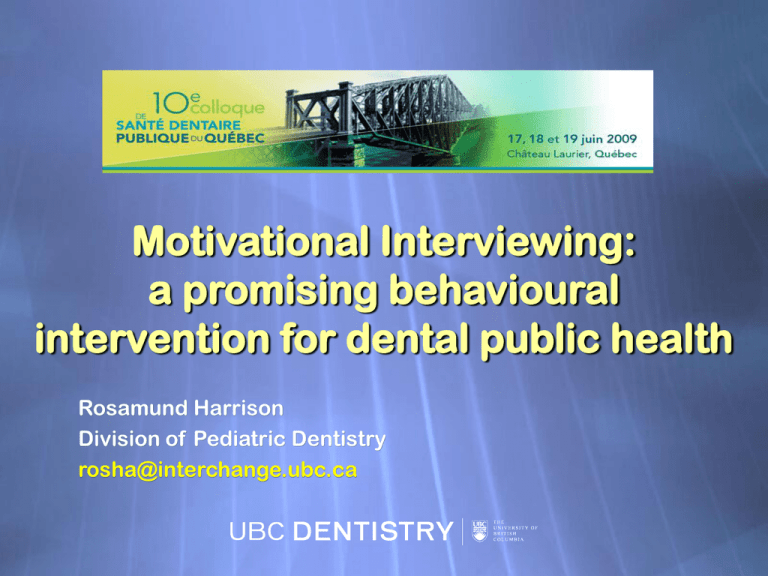
Motivational Interviewing:
a promising behavioural
intervention for dental public health
Rosamund Harrison
Division of Pediatric Dentistry
rosha@interchange.ubc.ca
Outline
Caries: multifactorial etiology
Traditional advice-giving
Process of change
“Spirit” of MI
Principles of MI
MI and the dental setting
Early childhood caries
[images courtesy of Dr. Young Tze Kuah]
Caries:
no simple causation pathway
Complex: multifactorial
“action of genes,
environmental factors and
risk-conferring behaviours”
“biology, behaviour and
genetics do not completely
explain caries.”
Fejerskov O. “Changing paradigms in concepts on dental caries:
consequences for oral health care.” Caries Res 38: 2004
Controlling caries is not just:
Killing one microorganism
Improving tooth resistance
Preventing mutation in one gene
Managing one environmental factor
Fejerskov O. “Changing paradigms in concepts on dental caries:
consequences for oral health care.” Caries Res 38: 2004
The main determinants of health
Determinants of
oral health
Economic, Political
& Environmental
Conditions
Poverty
Social &
Community
Context
Housing
Sanitation
Social norms
Leisure Facilities
Shopping Facilities
Peer Groups
Diet
Employment
Work/educational
environment
Income
Policy - International
Social Capital
Hygiene
Smoking
Cultural
Identity
- National
- Local
Oral
Health
Related
Behaviour
Alcohol
Individual
Sex
Oral
Age
Genes
Health
Biology
Injury
Service
Social network
Commercial Advertising
Watt 2003
Experience of
changing your
behaviour?
Difficulty of changing an
existing or
adopting a new behaviour?
not important: what I am
doing is okay and I like to do it!
not confident: too hard!
Listening to parents whose
children had dental treatment
under general anesthesia
“Well, I have an
experience…we
talk to a dentist,
the rate was
$100/hr. They
gave us a onehour long lesson
about how to
take care of our
child’s teeth…”
Amin M, Harrison R.
Pediatr Dent 29: 2007
“At
the end, the
only thing we got
out from it was to
chew gum. The
things we got out
from it could also
be found in the
newspaper and
books, so why do
we still have to
take that onehour lesson from
the dentist?”
Advice-giving
Describes or
recommends a
preferred
course of action”
“you should”
“you ought to…”
Advice-giving: two elements
Information
Persuasion
Telling people what to do
undermines autonomy
generates resistance
Frustrated
!!!
The Transtheoretical Model:
a framework for understanding the
process of change
“Stages of change”
James Prochaska and Carlo DiClemente
importance of tailoring intervention
to individual’s stage of change
Action
Preparation
Precontemplation
Maintenance
Contemplation
Stages of Change
Prochaska et al, 1991
Pre-contemplation
Individual has problem
(may not recognize it) and
has no intention of changing
traditional health promotion & health
education
not designed for such individuals
doesn’t match their needs
Contemplation
Individual recognizes the problem;
seriously thinking about changing
more aware of pros; even more
aware of cons
balance between costs/benefits of
change = ambivalence
stuck here for long time
Preparation for change
Individual recognizes problem and
intends to change behaviour soon. Some
change efforts reported
intending to take action in immediate
future, e.g. consult professional
some significant action in the past year
Action
consistent behaviour change
made specific
modifications in practices
risk of relapse
Maintenance
working to prevent relapse
Termination
change habitual and embedded
Stages of change: Remember!
people move backwards &
forwards
if you talk to people expecting
them to be further along;
expect resistance!
Stages of change:
Remember!
parent may not be ready
likely won’t say
“I want to change”
different stages of “readiness” =
be flexible!
Applying stages of change to
an intervention:
Motivational Interviewing
“M. I.”
William Miller
Stephen Rollnick
Work with problem drinkers
Miller 1978
control group (advice,
self-help book)
experimental group
(10 sessions)
same improvement
better than wait-list!
predictor of
success =
therapist
empathy
Motivational Interviewing
directive, patient-centred
counseling style for
eliciting behaviour change
by helping patients to explore
and resolve ambivalence
Rollnick and Miller, 1995
Motivational Interviewing
Directive:
practitioner
Patient-centred:
provides some patient has
structure
opportunity to
identify and resolve
behaviour change
issues
“SPIRIT of MI”
collaborate
negotiate
patient is expert
mechanism to change
respect autonomy
First principle of MI:
Express empathy
• see world
through
client's eyes
• share in
client’s
experience
2nd principle of MI:
Develop discrepancy
How client’s
current way of
being will not
fulfill their goal
3rd principle of MI:
“Roll with resistance”
skillful deflection of
client resistance
define problems,
then develop
solutions
4th principle of MI:
Support “self-efficacy”
you can do this!
no right way
others did it, so
can you
Parental efficacy
“Parents’ belief in their
ability to take action
and administer
parental control.”
Swick and Broadway. J of Instructional Psychology 24: 1997
Familial and cultural perceptions and beliefs of oral hygiene and dietary
practices among ethnically and socio-economically diverse groups.
Adair P, Pine C et al. Community Dental Health 2004:21
2822 parents of 3-4 year olds
Parental efficacy (self-belief)
and attitudes were strongest
predictors of
establishing toothbrushing
behaviour and
controlling sugar snacking
Skills and strategies:
more than “being nice!”
Open-ended questions
allow expression of concerns, problems
Affirmations
enhance self-efficacy
Reflective listening
active listening
clarifying not just repeating
Summarizing
reach joint decisions
In the dental setting?
Practical application
Time
for training and practice
for follow-up
Short time with family
Not our training!
more “action-oriented”
Not easy!
reflective listening
open-ended questions
Principle #1: empathy
Show concern
Get parent talking about child
open-ended questions
“what is it like to be ...’s
Mom?”
“tell me more….”
“it must be hard to…..”
Principle #2:
Explore discrepancy
Explore discrepancy between
what parent wants for child’s
dental health
straight teeth
no toothaches
Explore discrepancy between
what parent believes will happen
children have bad teeth
baby teeth not important
too hard to do anything about it
Make a “list”
Pros
Cons
Principle #3:
“Roll with resistance”
baby teeth not important
don’t argue or disagree
“dentists used to think…”
“do bad teeth run in your
family?”
“tell me about other children’s
teeth?”
Principle #4:
Support self-efficacy
you are a really
good mother!
you are doing a
great job of
being a mom
being here
today is a good
sign
Summarize
“Tell me again what you want
for ………’s teeth”
Transition to a menu
“I have spoken with other
mothers and these are some ideas
that they had about good teeth…”
Summarize
Using the menu
“worked for other mothers; may
not work for you”
focus on the behaviour that parent
is most likely to change
Ideas of your own?
Identify potential problems
and solutions
Problems and solutions
“What might go wrong?”
“Who can help?”
“Other good things that might
happen when you……….”
stop giving bottle when child
wakes = sleep through night
Summary
Give copy of menu
Anticipate problems
Encourage contact
Commitment check
“…it is your choice, not mine, to go
ahead.
“if you are unsure, think about it”
Follow-up
Telephone, email, in person, postcard
Important
encouragement
problems
prevent relapse
Confidence
Readiness
Change
Empathy
Motivational
Interviewing
Hope
Collaboration
Thank you!


